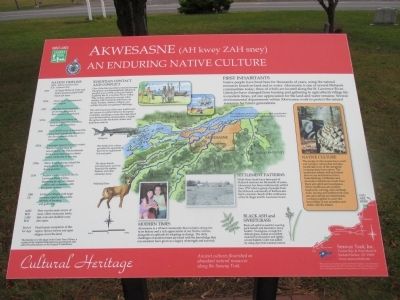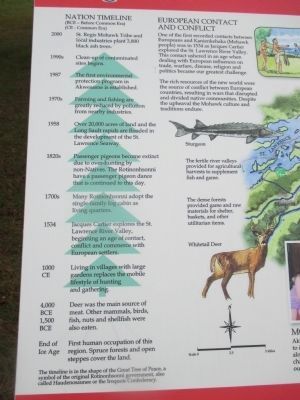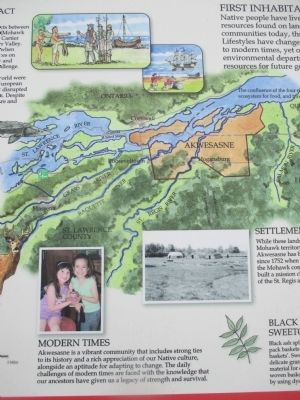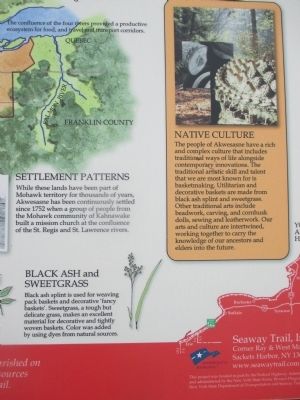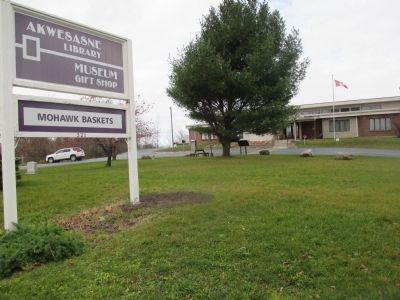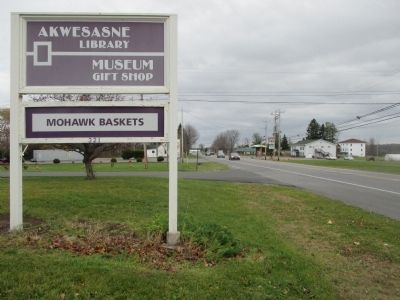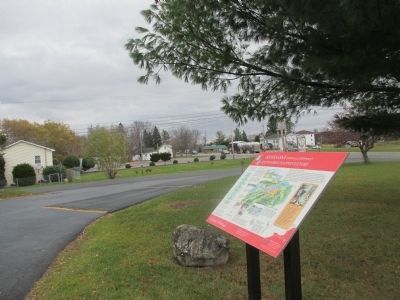Akwesasne in Franklin County, New York — The American Northeast (Mid-Atlantic)
Akwesasne (AH kwey ZAH sney)
An Enduring Native Culture
Cultural Heritage- Ancient cultures flourished on abundant natural resources along the Seaway Trail.
First Inhabitants
Native people have lived here for thousands of years, using the natural resources found on land and in water. Akwesasne is one of several Mohawk communities today, three of which are located along the St. Lawrence River. Lifestyles have changed from hunting and gathering to agricultural village life to modern times, yet our appreciation for the land and water remains. Several environmental departments within Akwesasne work to protect the natural resources for future generations.
The confluence of the four rivers provided a productive ecosystem for food, and travel and transport corridors.
Settlement Patterns
While these lands have been part of Mohawk territory for thousands of years, Akwesasne has been continuously settled since 1752 when a group of people from the Mohawk community of Kahnawake built a mission church at the confluence of the St. Regis and St Lawrence rivers.
Native Culture
The people of Akwesasne have a rich and complex culture that includes traditional ways of life alongside contemporary innovations. The traditional artistic skill and talent that we are most known for is basket making. Utilitarian and decorative baskets are made from black ash splint and sweetgrass. Other traditional arts include beadwork, carving, and cornhusk dolls, sewing and leatherwork. Our arts and culture are intertwined, working together to carry the knowledge of our ancestors and elders into the future.
Black Ash and Sweetgrass
Black ash splint is used for weaving pack baskets and decorative 'fancy baskets'. Sweetgrass, a tough but delicate grass, makes an excellent material for decorative and tightly woven baskets. Color was added by using dyes from natural sources.
European Contact and Conflict
One of the first recorded contacts bewteen Europeans and Kanienkehaka (Mohawk people) was in 1534 as Jacques Cartier explored the St. Lawrence River Valley. The contact ushered in an age when dealing with European influences on trade, warfare, disease, religion and politics became our greatest challenge.
The rich resources of the new world were the source of conflict between European countries, resulting in wars that disrupted and divided native communities. Despite the upheaval the Mohawk culture and traditions endure.
Sturgeon. The fertile river valleys provided for agricultural harvests to supplement fish and game.
The dense forests provided game and raw materials for shelter, baskets, and other utilitarian items. Whitetail Deer.
Modern Times
Akwesasne is a vibrant community that includes strong ties to its history and a rich appreciation of our Native culture, alongside an aptitude for adapting to change. The daily challenges of modern times are faced with the knowledge that our ancestors have given us a legacy of strength and survival.
Nation Timeline
(BCE- Before Common Era)
(CE- Common Era)
2000 St. Regis Mohawk Tribe and local industries plant 3,800 black ash trees.
1990s Clean-up of contaminated sites begins.
1987 The first environmental protection program in Akwesasne is established.
1970s Farming and fishing are greatly reduced by pollution from nearby industries.
1958 Over 20,000 acres of land and the Long Sault rapids are flooded in the development of the St. Lawrence Seaway.
1820s Passenger pigeons become extinct due to over-hunting by non-natives. The Rotinonhsonni have a passenger pigeon dance that is continued to this day.
1700s Many Rotinonhsonni adopt the single-family log cabin as living quarters.
1534 Jacques Cartier explores the St. Lawrence River Valley, beginning an age of contact, conflict and commerce with European settlers.
1000 CE Living in villages with large gardens replaces the mobile lifestyle of hunting and gathering.
4,000 BCE 1,500 BCE Deer was the main source of meat. Other mammals, birds, fish, nuts, and shellfish were also eaten.
End of Ice Age First human occupation of this region. Spruce forests and open steppes cover the land.
The timeline is on the shape of the Great Tree of Peace, a symbol of the original Rotinonhsonni government, also called Haudenosaunee or Iroquois Confederacy.
Seaway Trail, Inc. Corner Ray & West Main St., Sackets Harbor, NY 13685. www.seawaytrail.com . America's Byways. This project was funded in part by the Federal Highway Administration and administered by the New York State Scenic Byways Program of the New York State Department of Transportation and Seaway Trail, Inc.
Erected by Seaway Trail, Inc.
Topics and series. This historical marker is listed in these topic lists: Colonial Era • Native Americans. In addition, it is included in the Great Lakes Seaway Trail National Scenic Byway series list. A significant historical year for this entry is 1752.
Location. 44° 58.72′ N, 74° 41.623′ W. Marker is in Akwesasne, New York, in Franklin County. Marker can be reached from the intersection of New York State Route 37 and Library Road. Marker is at the apex of the loop road to the front door of the Akwesasne Library, Museum, and Gift Shop. The marker faces the building. Marker is on the north side of NY 37 generally midway between the hamlet of Hogansburg and the NY 37 bridge over the Raquette River. Touch for map. Marker is at or near this postal address: 321 NY Route 37, Hogansburg NY 13655, United States of America. Touch for directions.
Other nearby markers. At least 8 other markers are within 5 kilometers of this marker, measured as the crow flies. Raquette River (approx. 1.4 miles away); Blueway Trail (approx. 1.4 miles away); a different marker also named Raquette River (approx. 1.4 miles away); a different marker also named Blueway Trail (approx. 1.4 miles away); The French Presence in Cornwall (approx. 2.9 miles away in Canada); Co-Cathedral of the Nativity of the Blessed Virgin Mary (approx. 4.7 kilometers away in Canada); The Flying Frenchmen (approx. 4.7 kilometers away in Canada); Cornwall & S.D.G. 1784-2009 (approx. 4.8 kilometers away in Canada). Touch for a list and map of all markers in Akwesasne.
Also see . . .
1. St. Regis Mohawk Reservation - Wikipedia. (Submitted on November 30, 2014, by Anton Schwarzmueller of Wilson, New York.)
2. St. Regis Mohawk Tribe. (Submitted on November 30, 2014, by Anton Schwarzmueller of Wilson, New York.)
Additional keywords. Saint Regis Mohawk Reservation, St. Regis Mohawk Reservation
Credits. This page was last revised on August 24, 2021. It was originally submitted on November 30, 2014, by Anton Schwarzmueller of Wilson, New York. This page has been viewed 490 times since then and 19 times this year. Last updated on August 23, 2021, by Robert Rusaw of Massena, New York. Photos: 1, 2, 3, 4, 5, 6, 7. submitted on November 30, 2014, by Anton Schwarzmueller of Wilson, New York. • Devry Becker Jones was the editor who published this page.
